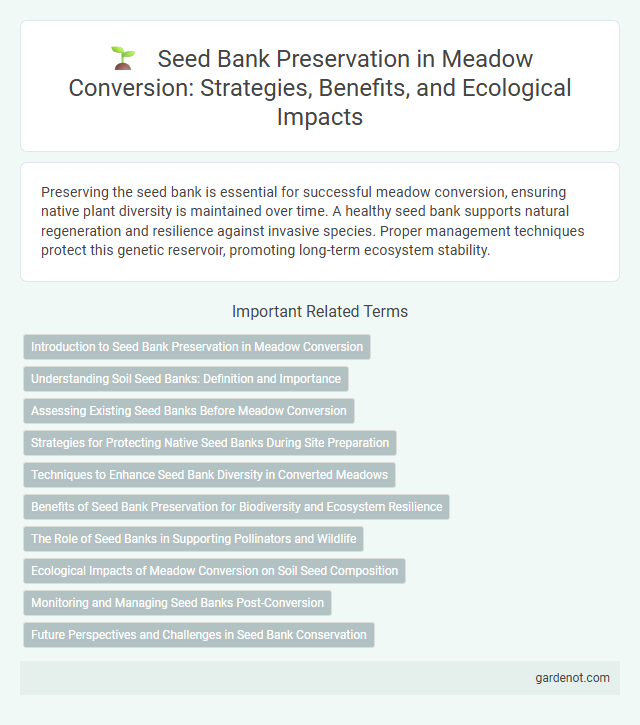Preserving the seed bank is essential for successful meadow conversion, ensuring native plant diversity is maintained over time. A healthy seed bank supports natural regeneration and resilience against invasive species. Proper management techniques protect this genetic reservoir, promoting long-term ecosystem stability.
Introduction to Seed Bank Preservation in Meadow Conversion
Seed bank preservation is essential in meadow conversion to maintain plant biodiversity and support ecosystem resilience. It involves collecting, storing, and managing viable seeds from native meadow species to ensure their availability for restoration and regeneration. Proper seed bank management enhances successful re-establishment of diverse plant communities during meadow conversion projects.
Understanding Soil Seed Banks: Definition and Importance
Soil seed banks consist of viable seeds stored in the soil, essential for natural regeneration and ecological resilience in meadow conversion projects. These seed reserves support biodiversity by maintaining native plant species and enabling adaptive responses to environmental changes. Effective management of soil seed banks ensures successful restoration and long-term sustainability of converted meadows.
Assessing Existing Seed Banks Before Meadow Conversion
Assessing existing seed banks before meadow conversion is critical to ensure native species prevalence and ecosystem resilience. Soil sampling and seed viability testing provide essential data on seed diversity and density, guiding restoration strategies effectively. Understanding seed bank composition aids in predicting vegetation outcomes and minimizing invasive species establishment during meadow restoration.
Strategies for Protecting Native Seed Banks During Site Preparation
Implementing minimal soil disturbance techniques preserves the integrity of native seed banks during site preparation for meadow conversion. Strategic timing of site activities aligns with seed dormancy periods, reducing seed predation and disruption. Utilizing buffer zones around sensitive seed bank areas further protects native flora diversity and enhances long-term meadow restoration success.
Techniques to Enhance Seed Bank Diversity in Converted Meadows
Enhancing seed bank diversity in converted meadows relies on techniques such as collecting seeds from a wide range of native plant species and employing stratified seed sowing that mimics natural spatial distribution patterns. Incorporating soil transplants from established meadows introduces a diverse microbial community and dormant seed reserves, promoting ecological resilience. Regular monitoring of species composition and adaptive management interventions ensure the maintenance of seed bank heterogeneity and ecosystem functionality.
Benefits of Seed Bank Preservation for Biodiversity and Ecosystem Resilience
Seed bank preservation secures genetic diversity critical for ecosystem resilience and adaptive capacity in changing climates. Conserving native meadow species through seed banks supports habitat restoration, enhances pollinator populations, and stabilizes soil health. This method safeguards against species loss and ensures long-term sustainability of meadow ecosystems globally.
The Role of Seed Banks in Supporting Pollinators and Wildlife
Seed banks play a crucial role in preserving genetic diversity essential for meadow conversion projects that support pollinators and wildlife. By storing native wildflower and grass seeds, seed banks ensure the availability of resilient species adapted to local ecosystems, promoting habitat restoration and biodiversity. These preserved seeds contribute to stable food sources and breeding grounds, vital for sustaining pollinator populations such as bees, butterflies, and other wildlife dependent on meadow habitats.
Ecological Impacts of Meadow Conversion on Soil Seed Composition
Meadow conversion significantly alters soil seed composition by reducing native species diversity and favoring opportunistic weed seeds, disrupting the natural seed bank balance crucial for ecosystem resilience. Changes in soil disturbance and nutrient levels during conversion processes negatively impact the viability and germination rates of rare native seeds preserved in the seed bank. The decline in native seed bank richness leads to long-term ecological consequences, including reduced habitat quality for pollinators and other meadow-dependent wildlife.
Monitoring and Managing Seed Banks Post-Conversion
Monitoring and managing seed banks post-meadow conversion ensures genetic diversity and ecosystem resilience are maintained. Regular viability tests and population assessments track seed health and regeneration potential, allowing for timely interventions. Proper storage conditions and periodic replenishment protocols prevent seed degradation and support long-term habitat restoration goals.
Future Perspectives and Challenges in Seed Bank Conservation
Seed bank preservation faces evolving challenges amid climate change and habitat loss, necessitating advanced cryopreservation techniques and genetic diversity monitoring. Future perspectives emphasize integrating genome sequencing and AI-driven data analysis to enhance seed viability and adaptive trait identification. Addressing funding limitations and global coordination remains crucial for sustainable seed bank conservation efforts.
Seed bank preservation Infographic

 gardenot.com
gardenot.com